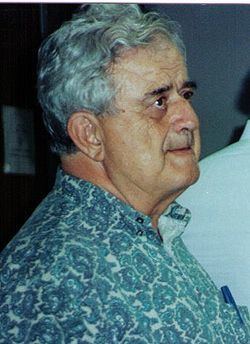Nationality American Role Physicist | Name Marshall Rosenbluth Fields Physics | |
 | ||
Born February 5, 1927Albany, New York ( 1927-02-05 ) Institutions General AtomicsUCSDPrinceton UniversityUniversity of Texas at Austin Alma mater Stuyvesant High SchoolUniversity of ChicagoHarvard University Known for Plasma PhysicsRosenbluth potentialsMetropolis algorithmRosenbluth formula Died September 28, 2003, San Diego, California, United States Notable awards Albert Einstein Award (1967), Enrico Fermi Award (1985), Hannes Alfven Prize (2002) | ||
Residence United States of America | ||
John Wheeler - Computing and the H-bomb. Marshall Rosenbluth, John Sheldon (68/130)
Marshall Nicholas Rosenbluth (5 February 1927 – 28 September 2003) was an American plasma physicist and member of the National Academy of Sciences. In 1997 he was awarded the National Medal of Science for discoveries in controlled thermonuclear fusion, contributions to plasma physics, and work in computational statistical mechanics. He was also a recipient of the E.O. Lawrence Prize (1964), the Albert Einstein Award (1967), the James Clerk Maxwell Prize in Plasma Physics (1976), the Enrico Fermi Award (1985), and the Hannes Alfvén Prize (2002).
Contents
- John Wheeler Computing and the H bomb Marshall Rosenbluth John Sheldon 68130
- Marshall Rosenbluth Wikipedia audio article
- Key scientific contributions
- Early years
- Additional information
- References

Marshall Rosenbluth | Wikipedia audio article
Key scientific contributions
During his first post-doctoral position at Stanford University (1949–1950), he derived the Rosenbluth formula, which was the basis of the analysis used by Robert Hofstadter in his Nobel prize-winning experimental investigation of electron scattering. Hofstadter refers to this in his 1961 Nobel Lecture: "This behavior can be understood in terms of the theoretical scattering law developed by M. Rosenbluth in 1950". In 1953, Rosenbluth derived the Metropolis algorithm; cited in Computing in Science and Engineering (Jan. 2000) as being among the top 10 algorithms having the "greatest influence on the development and practice of science and engineering in the 20th century." However, by the late 1950s, Rosenbluth turned his attention to the burgeoning discipline of plasma physics and quickly laid the foundation for many avenues of research in the field, particularly the theory of plasma instabilities. Although he continued to work on plasma physics for the remainder of his career, he often made forays into other fields. For example, around 1980, he and coworkers produced a detailed analysis of the free electron laser, indicating how its spectral intensity can be optimized. He maintained a high productivity rate throughout his entire career. Indeed, only a few years before his death, Rosenbluth discovered the existence of residual flows (so-called Rosenbluth-Hinton flows), a key result for understanding turbulence in tokamaks.
Early years
Rosenbluth graduated from Stuyvesant High School in 1942. He did his undergraduate study at Harvard, graduating in 1946 (B.S., Phi Beta Kappa), despite also serving in the U.S. Navy (1944–46) during this period. He received his Ph.D. in 1949 from the University of Chicago. In 1950, Edward Teller, considered the father of the hydrogen bomb, recruited Rosenbluth to work at Los Alamos. Rosenbluth maintained this position until 1956. The research he conducted at Los Alamos led to the development of the H-bomb.
Additional information
Upon his retirement, he took on the responsibility of chief scientist of the Central Team for the International Thermonuclear Experimental Reactor (ITER) until 1999. Rosenbluth also served as a member of the JASON Defense Advisory Group.
Rosenbluth was affectionately known as the Pope of Plasma Physics in reference to his deep understanding of the field.
